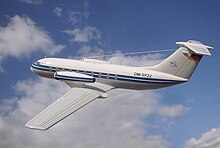155 (airplane)
| 155 | |
|---|---|
 Model of the airliner 155 in the Dresden Transport Museum |
|
| Type: | Airliner |
| Design country: | |
| Manufacturer: | |
| First flight: |
Project was canceled |

The 155 was a developed in the late 1950s study of a German passenger plane with jet engine (TL-drive). Alongside the 152 and 153, it was the most advanced aircraft construction project in the German Democratic Republic (GDR). The VEB Flugzeugwerke Dresden (FWD) planned it and produced a dummy on a 1: 1 scale. After the lack of orders from the Soviet Union and other countries, as well as delays in the development of the aircraft and the intended engine, the project was discontinued.
history
In addition to the license production of the Il-14 and the development of the 152 , the aircraft factory in the Dresden district of Klotzsche began to develop successor models at an early stage. According to an initial concept, the 155 was to cover distances of up to 3900 km and, depending on the equipment, be able to carry 56 (luxury version) to 70 (tourist class) passengers. The possibility of quick conversion into a cargo plane was provided.
Initially, the type was to be equipped with Soviet turboprop engines (PTL), later it was planned to use the PTL Pirna 018 engine . After it had been in the testing of the second copy of this engine on February 7, 1958 an accident with the destruction of the engine and the entire test stand, the decision was made to avoid further delays, the turbojet engine instead Pirna 014 use, the was also used in the 152. Since this had a significantly lower performance, the dimensions of the aircraft and thus also the performance parameters were greatly reduced. Later, the plan was to switch to the Pirna 020 engine, which was still to be developed, but which, according to the plans, would not have been available until 1966.
Various preliminary studies and wind tunnel models were created. It was decided to use a low-wing aircraft. Since the ground clearance of the wings was too low to accommodate the intended engine underneath, the engines were placed on the wings, similar to the VFW 614 later . Finally, a 1: 1 dummy of the aircraft was built. The production of individual parts was already taken into account in the plans of the aircraft factory, and parts production may have already started. In the last project on August 30, 1960, the 155 was described as the successor to the Il-14. However, there was no confirmation of the technical project.
In 1960 it became clear that the Soviet Union had largely completed preparations for series production of the Tupolev Tu-124 , which covered a similar range of tasks. Thus the sales chances in the socialist countries had fallen drastically. In the meantime, more powerful types were also about to be introduced in western countries. The 155, next to the 152 the last project that was still seriously pursued, could not prevent the end of the aircraft industry in the GDR. At the end of this, the project was discontinued.
construction
The 155 was planned as a cantilever, unarrowed low-wing aircraft with a retractable three-legged landing gear with nose wheel. The aircraft should have a pressurized cabin. The main landing gear should move into the cowling of the engines. The horizontal stabilizer was attached above the fuselage so that it was not in the exhaust flow of the engines.
Technical specifications
| Parameter | 155 (1955) | 155 (1959) |
|---|---|---|
| crew | 6th | |
| Passengers | 56-70 | 44-48 |
| length | 34.20 m | 24.21 m |
| span | 36.80 m | 21.20 m |
| height | 7.93 m | |
| Wing area | 170 m² | 60.0 m² |
| Wing extension | 8.0 | 7.5 |
| Top speed | 725 km / h | 742 km / h |
| Cruising speed | 700 km / h | 650-700 km / h |
| Service ceiling | 6000 m | |
| Max. Range | 3900 km | 1635 km |
| Empty mass | 29,500 kg | 11,800 kg |
| Takeoff mass | 52,570 kg | 21,000 kg |
| Engines | two PTL | two TL Pirna 014 |
| power | 2 × 6250 kW | 2 × 3677 kW |
| Take-off run | 700 m | 900 m |
| Landing runway | 630 m | 510 m |
literature
- Holger Lorenz : The passenger jet 152 , p. 24, ISBN 3-931770-45-1 .
- Reinhard Müller: Brunolf Baade and the aviation industry of the GDR: The true story of the jet airliner 152 . 1st edition. Sutton, Erfurt 2013, ISBN 3-95400-192-6 .
- Jochen Werner : Development of the 153 , in: Die Deutsche Luftfahrt, Vol. 22: Luftfahrt Ost 1945–1990 , Bernard & Graefe Verlag 1994, pp. 148–150, ISBN 3-7637-6109-8 .
Web links
Individual evidence
- ^ Müller, Brunolf Baade and the aviation industry of the GDR , pages 265–276
- ↑ Holger Lorenz : The passenger jet 152 , p. 80.
- ↑ Jochen Werner: Technical data of the aircraft types 153, 154, 155, 156, 157, 160 , in: Die Deutsche Luftfahrt, Vol. 22: Luftfahrt Ost 1945–1990 , Bernard & Graefe Verlag 1994, pp. 346–347.